NORTH WALES COAST RAILWAY:NOTICE BOARD
Rheilffordd arfordir gogledd Cymru: Hysbysfwrdd
13 April 2020
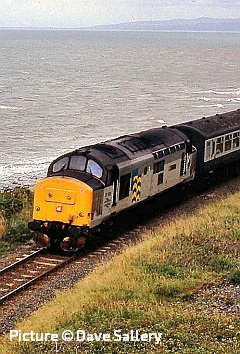
Forthcoming events
(see also our Calendar page for venues)
Note: we have removed all entries up to the end of May as the events are cancelled.
June 2020
Saturday 27 June Steam at Chester The Cheshireman (Railway Touring Company). 60163 London Euston - Chester and return.
July 2020
Sunday 19 July Steam on the Coast North Wales Coast Express (Railway Touring Company) LIverpool - Manchester - Holyhead (15:05 - 17:40).
Tuesday 21 July Steam on the Coast The Welsh Mountaineer (Railway Touring Company) Preston - Blaenau Ffestiniog and return
August 2020
September 2020
Saturday 5 September Steam at Chester 'The Cheshireman' (Railway Touring Company). Norwich to Chester. Loco 6233 for part of the journey.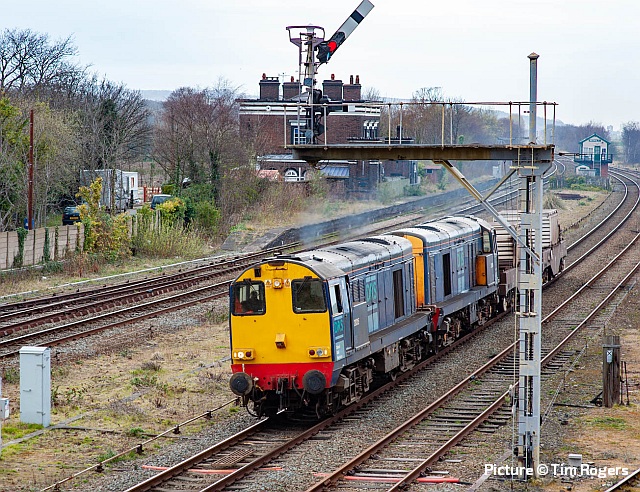
20 315 and 20 306 pass Holywell Junction with the 15:14 Valley to Crewe flasks, 2 April 2008. In 2020 Flask trains no longer run, the signal no longer stands, and DRS Class 20s are on the brink of extinction. Picture by Tim Rogers.
Look for another extra page on Friday morning, and keep those historic scenes coming. Does anyone have some from the 1970s? - Charlie
Seen at Crewe
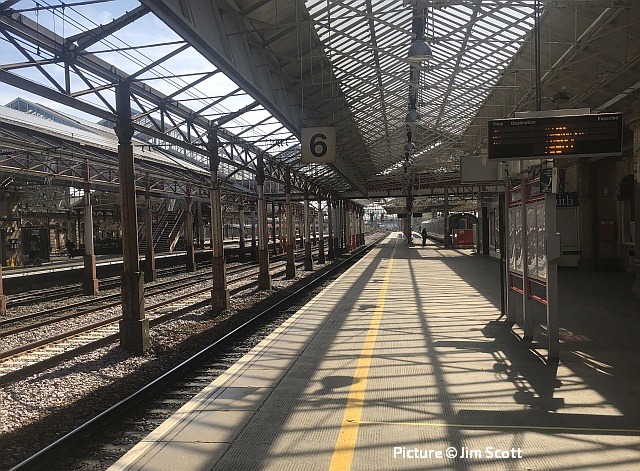
Train driver Jim Scott was at Crewe station while on duty on 7 April and took these images for us. Rarely can Platform 6 be so deserted at lunchtime.
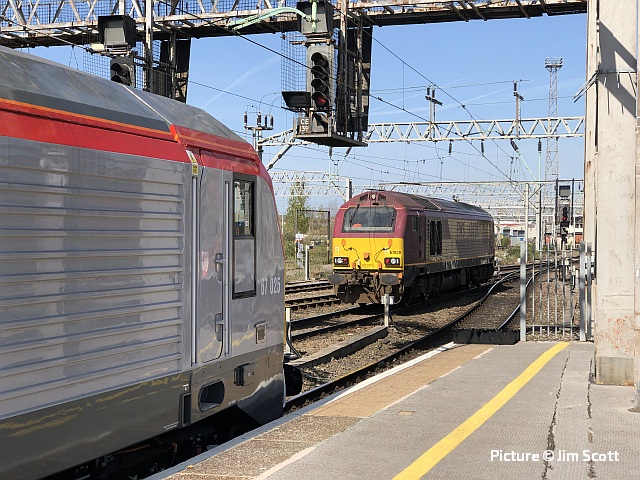
Present was 67 025 with one of the Transport for Wales, ex-East Coast carriage sets, working empty from Crewe Carriage Sidings to Holyhead. 67 020, still in full EWS livery, is in the background.
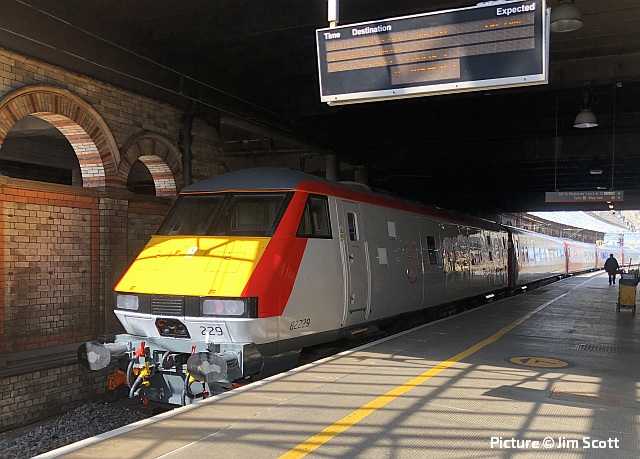
Driving Van Trailer 82229.
47s in 2003 - pictures by Tim Rogers
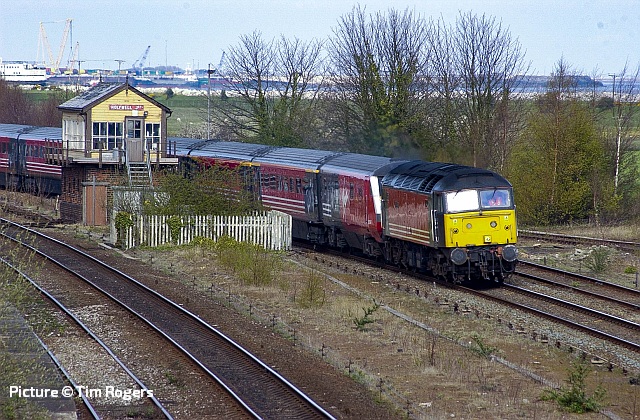
2003 was a bumper year for Class 47 enthusiasts, the locos appearing on some Virgin and First North Western services. 10 April 2003 saw 47 843 Vulcan passing Holywell Junction on Virgin's 1A49 09:21 Holyhead to Euston.
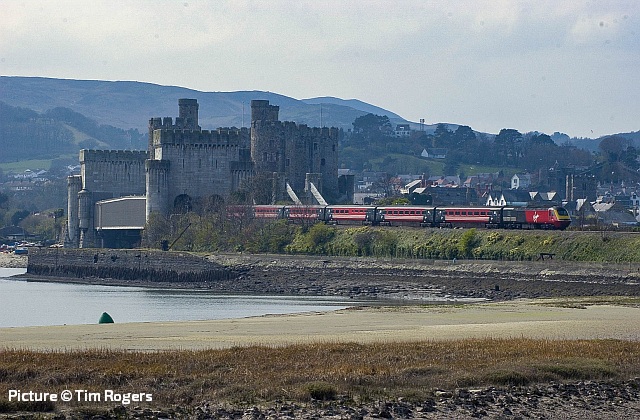
HSTs also appeared on Virgin services, as seen on 11 April 2003, approaching Llandudno Junction. 43 101 County of Derbyshire and 43 084, working 1A77 13:43 Holyhead to Euston.
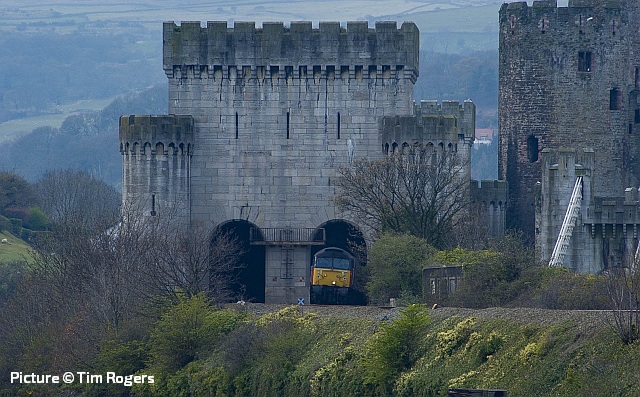
47 769 Royal Mail Tyneside on the 1G11 14:00 Holyhead to Birmingham New Street First North Western service, formed of carriages borrowed from sister company First Great Western.
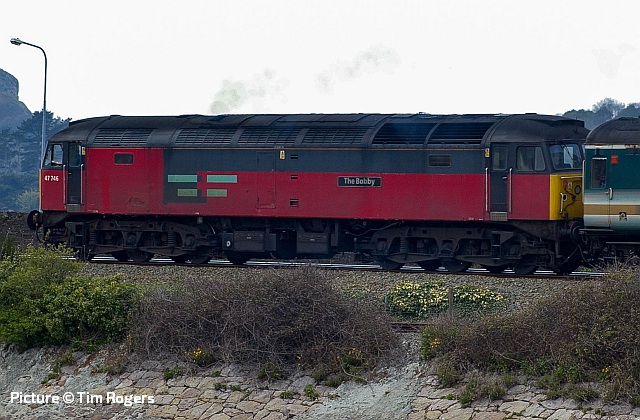
47 746 The Bobby: 1D71 12:21 Birmingham New Street to Holyhead.
From Dave Sallery's archive
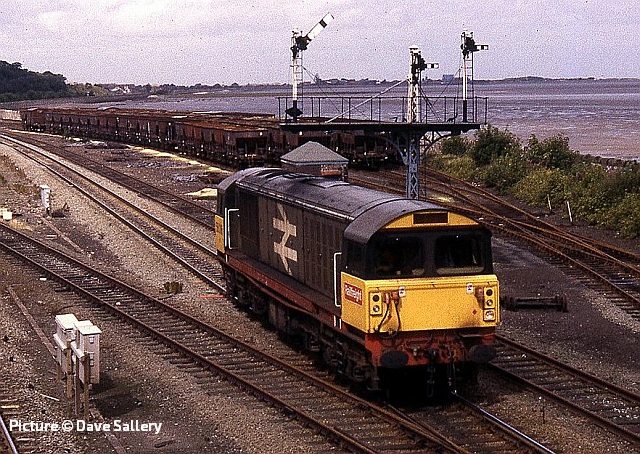
Class 58s were always rare in North Wales. However in 1985 a new coal flow started from Toton to Garston Docks on Merseyside. As the Speke Junction men were not trained on the Class 58 a number of crew training turns ran to Llandudno Junction from Speke Junction. 58 016 is seen here heading back to Merseyside on one such turn passing Mostyn on 21 August. Note the large number of hopper wagons, used for carrying sulphur to Amlwch, in the background.
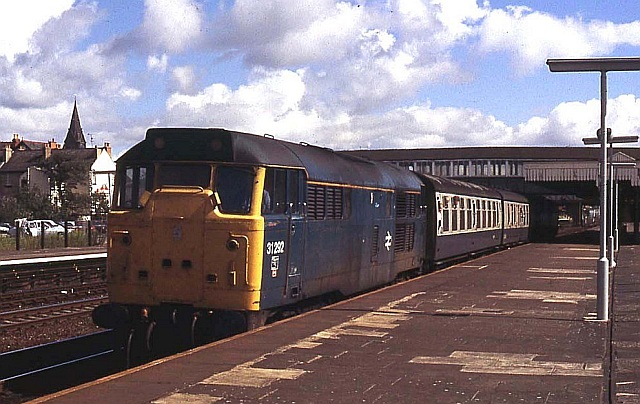
31 August 1989 at Rhyl, 31 292 with a three-coachwestbound train complete with window-hanging'bashers.' Only the 31/4 variety were equipped for electric heating of trains, but the passengers on thissummer day would not have missed it.
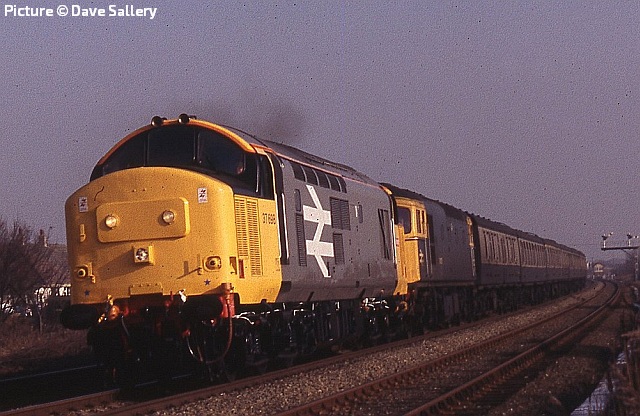
In 1986 the rebuilding of Class 37 locos for further service to 37/4 passenger engines, and 37/5 and 37/7 for freight was under way at Crewe works. Locos after overhaul would often be sent 'down the coast' and back, normally with another loco for insurance and a rake of withdrawn coaches. However 37 698 (the penultimate 37/5 conversion) seen near Prestatyn on 12 February 1986 was undergoing a trial by double-heading, with 33 037, the 11:15 Crewe - Bangor passenger train and the 14:17 Bangor - Cardiff, the 37 being detached at Crewe. 37 698 was withdwan in 2009 and scrapped.
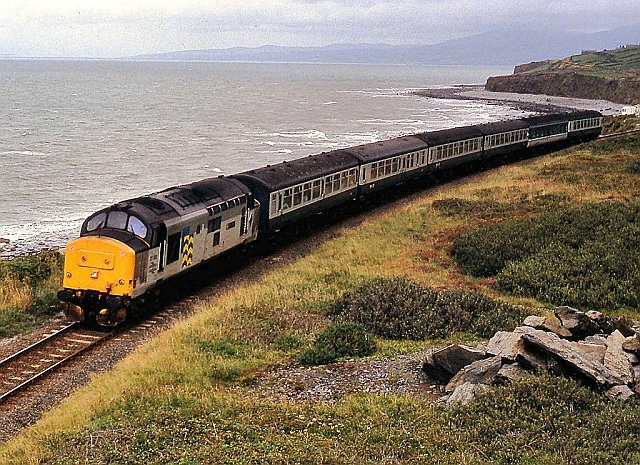
On the Cambrian Coast on 17 August 1991, 37 418 Conidae, near Llwyngwril with the 09:36 Pwllheli - Birmingham New Street, taking home happy campers from Butlin's Pwllheli. These summer saturday turns were worked, to the delight of many enthusiasts, by 37/4s hired from the freight sector. (The petroleum sub-sector had a small fleet of 37s for lines on whch the 47s were considered too heavy, such as the weekly Stanlow - Aberystwyth service.) In 1993, 37418 became one of the regulars on the Regional Railway North Wales passenger services, gaining the name East Lancashire Railway. It was later bought from preservation, and survives today in the Colas fleet, having recently served on the Cardiff - Rhymney route.
Chester's steam rail crane - recalled by Peter Neve
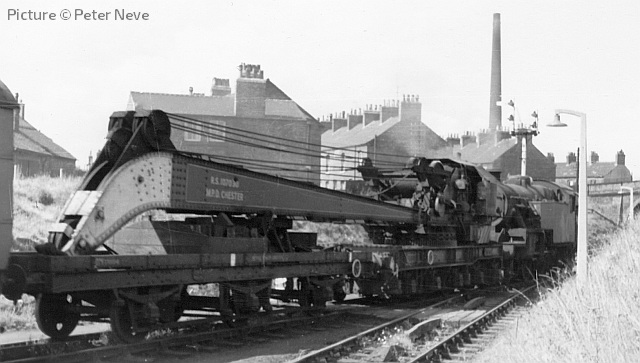
Stanier Class 4 2-6-4 42647 draws the Chester (shed 6A) breakdown train on to the main line for its next turn of duty in July 1966. 42647 was also a regular performer on passenger trains between Chester and Birkenhead at this time.
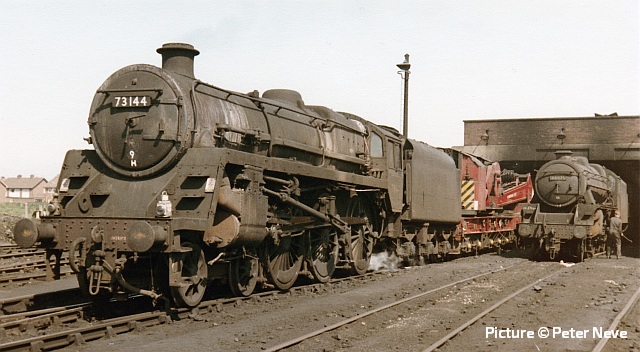
Standard Class 5 4-6-0 73144 (fitted with Caprotti valve gear) stands ready to take the breakdown crane to its next assignment, having been moved from its storage siding to the north side of the shed. The locomotive’s home shed (9H, Patricroft) can be seen painted on the buffer beam in black lettering. Meanwhile, a fitter is applying gentle persuasion to the running gear of Chester-based Stanier Black 5 4-6-0 44875. The date was 31 May 1967 and the shed would be closed five weeks later.
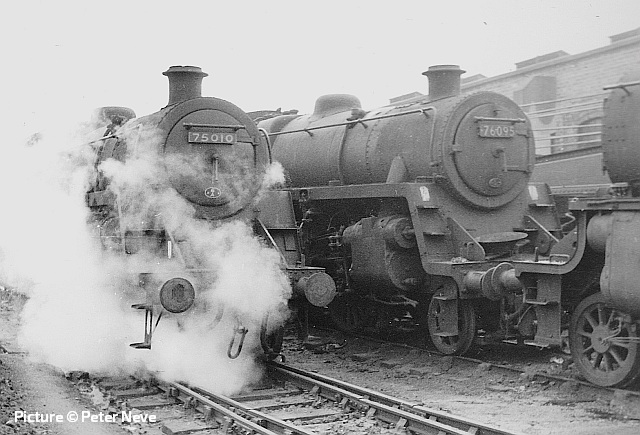
When not in use, the breakdown crane was usually parked on the siding adjacent to the north side of the shed. In April 1966 it can just be seen behind Standard Class 4 2-6-0 76095, which seems to be having some work done on the inside of the smokebox, with the chimney skirt resting on the front of the engine. Standard Class 5 4-6-0 75010 (with hand painted wooden number plate on the smokebox door) has just reached the eastern extremity of the shed having been coaled and watered, and is now preparing to move forward on to the ash disposal area.
A week over time: pictures by Tim Rogers
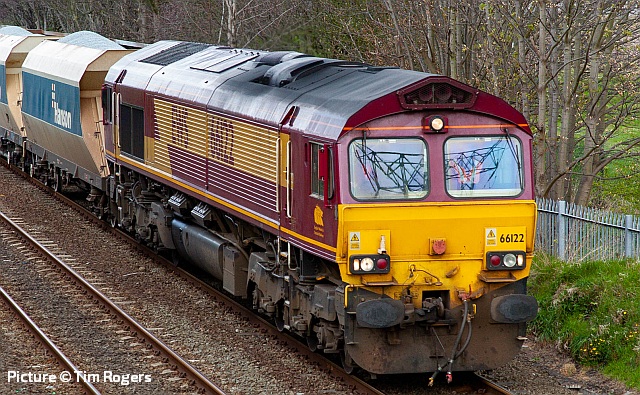
In 2005 Penmaenmawr quarry was dispatching granite by Rail to other Hanson sites, as when Tim photographed 66 122 passing Connah's Quay with 6Z50 10:47 Penmaenmawr to Acton on 9 April.
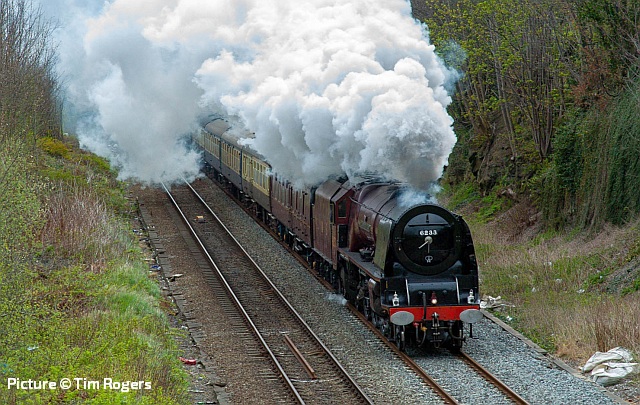
On the same day, steam traction in the impressive shape of 6233 Duchess of Sutherland on an excutsion from Ashford to Holyhead.
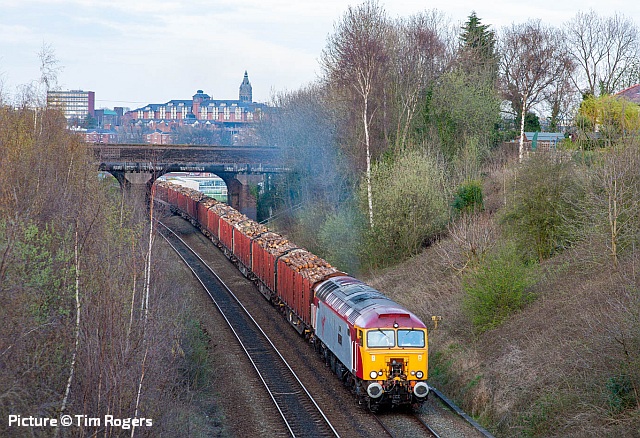
For a short time, Virgin's 'Thunderbird' Class 57s saw service on the log trains to the Kronisman works in Chirk. On 1 April 2005, 57 310 Kyrano hrads out of Chester with 6J37 12:51 (FX) Carlisle Yard to Chirk.
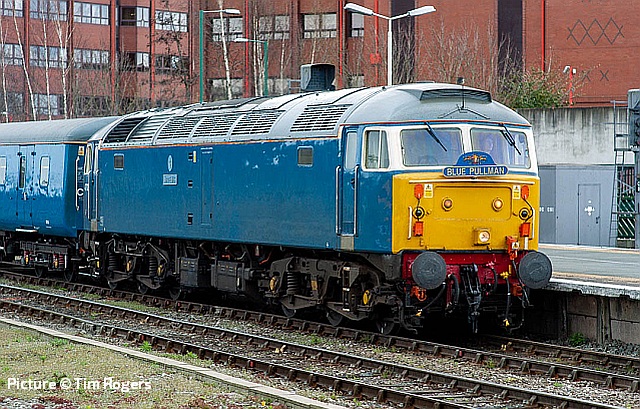
2006: On 8 April, 47 712 Artemis, in 'nanking blue' inspired by the Blue Pullman' diesel sets of the 1960s, and recently mentioned here on account of its current livery, arrives at Chester with the ill-fated 'Blue Pullman' set (formed of ex-BR Mk2 coaches) on an excursion from London...
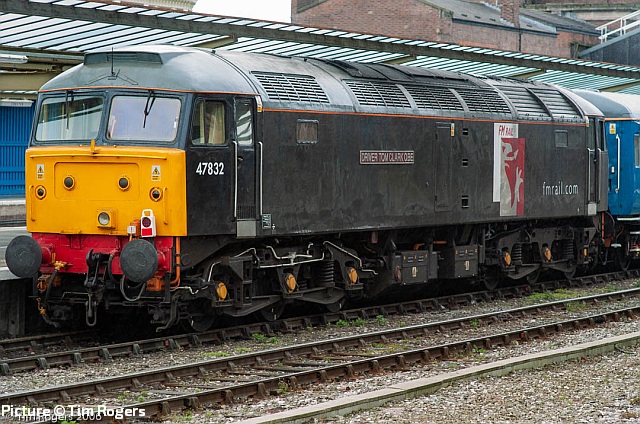
... on the rear, 47 832 Driver Tom Clark OBE in the livery of 'FM Rail' which was formed in 2005 by a merger of Fragonset (which apparently had a fleet of 75 old diesel locos) and Merlin Rail. Unfortunately for its shareholders it went into adminstration at the end of 2006 and ceased trading.
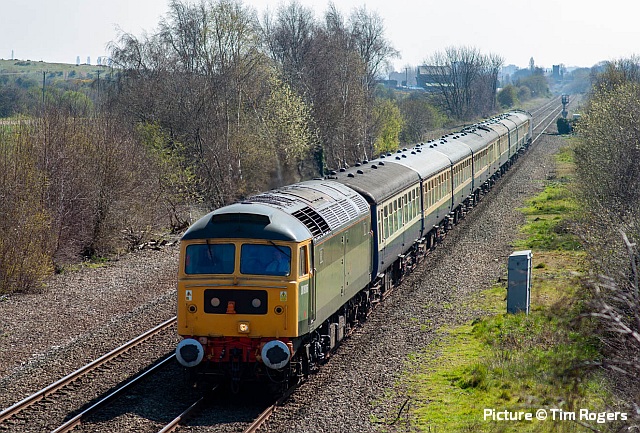
7 April 2007: 47 812 near Bagillt with an excursion from London ...
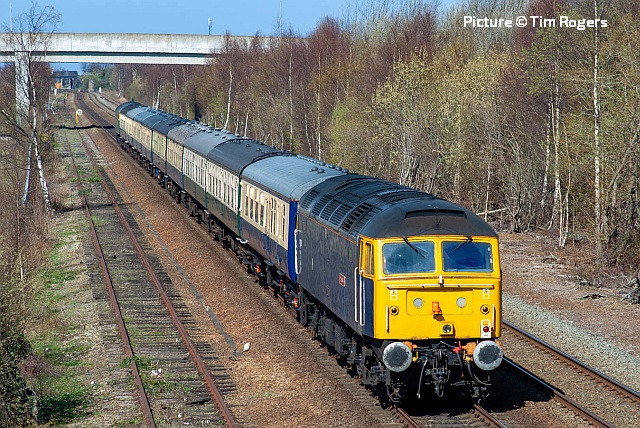
... and 47 839 Pegasus on the rear. Locos and coaches were provided by Riviera Trains.
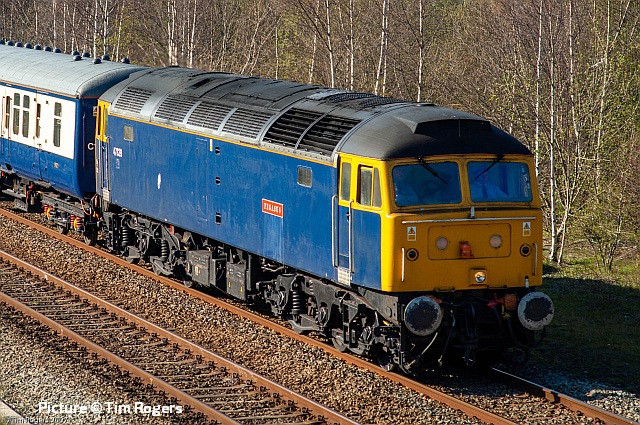
Portrait of 47 839 on the return near Sandycroft. The livery colour was described as 'Oxford Blue'. It had previously carried Virgin Livery and been named Pride of Saltley.
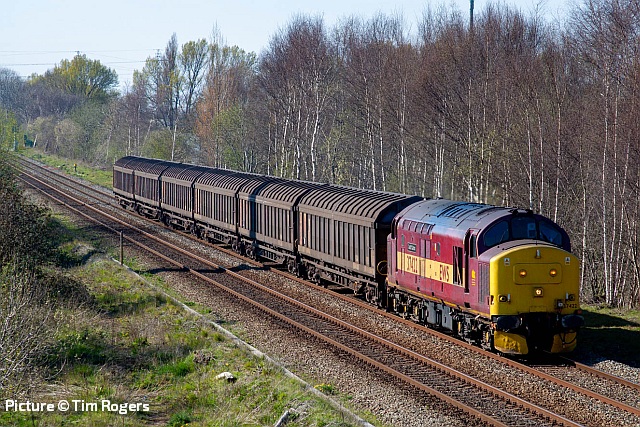
In 2007 the weekly freight from Holyhead Aluminium carrying wagons destined for Braunau am Inn was a highlight for photographers. On 7 April, sometime North Wales passenger loco 37 422, by this time named Cardiff Canton. was in charge.
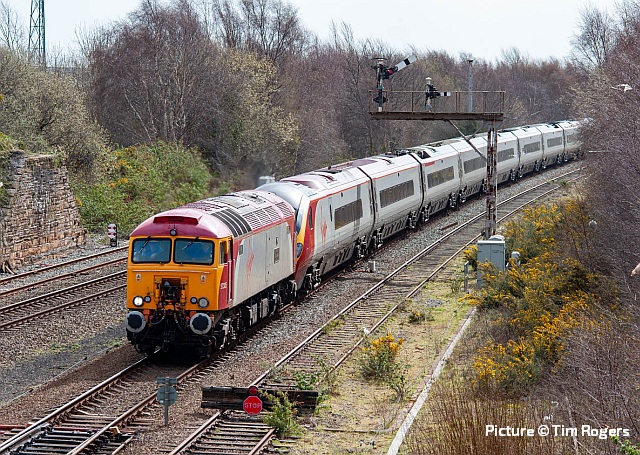
2008: on 1 April 57 305 John Tracy pulls 'Pendolino' 390 018 Virgin Princess past Holywell Junction's home signal with the 09:00 London Euston to Holyhead. Most London trains were in the hands of class 221 Voyagers by this period, but a single 57-hauled out-and back service continued.
North Wales locomotive classes – David Pool
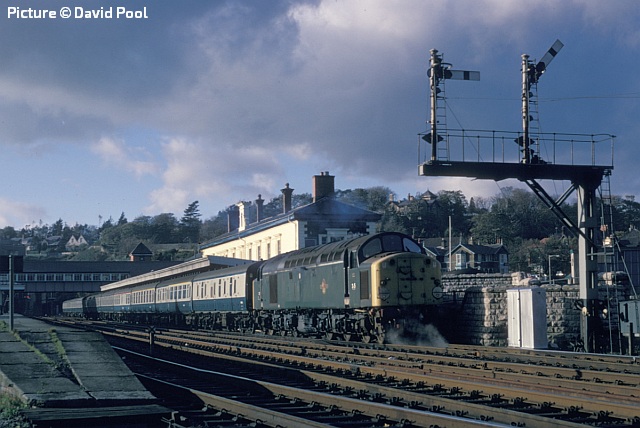
Above: Class 40 No. 315 is about to leave Bangor with the 14:57 to Euston on 6 November 1971. It is still in green livery, but has lost the “D” prefix and carries the later British Railways emblem.
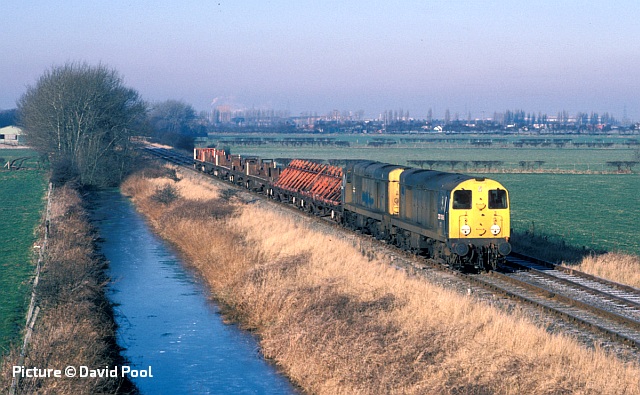
By 1987 the line between Dee Marsh Junction and Mickle Trafford had only a single track in use. On 31 January class 20s 20 065 and 20 106 were on 6S50, the 08:25 steel train from Dee Marsh to Mossend.
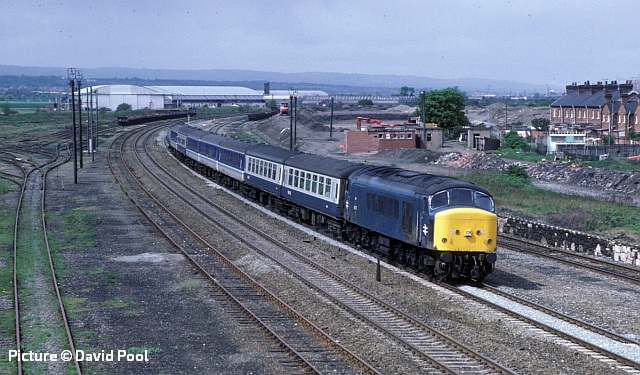
In 1987 the Transpennine services were generally worked by the class 45 or 46 diesels. The 1044 from Holyhead to Newcastle was being hauled by 45 127 on 2 May, passing the sidings at the site of Mold Junction shed.
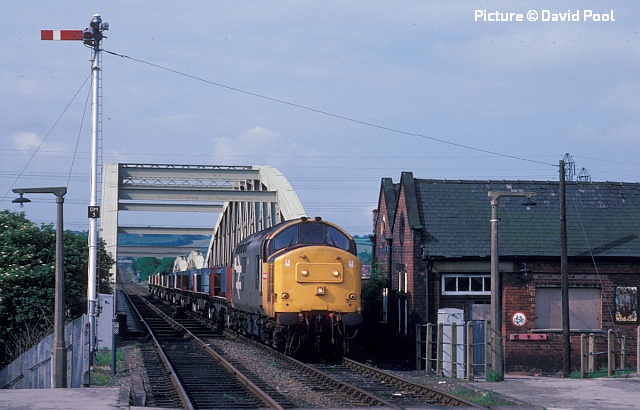
Six class 37s were given either Mirrlees or Ruston diesel engines in 1987 together with new alternators, bogies and ballast weights to evaluate the haulage capability of a single locomotive on the heavy steel trains in and from South Wales. In the first week of operation on 14 June 1987, 37 906 had brought the overnight train from Llanwern to Shotton, nearing journey’s end at Hawarden Bridge.
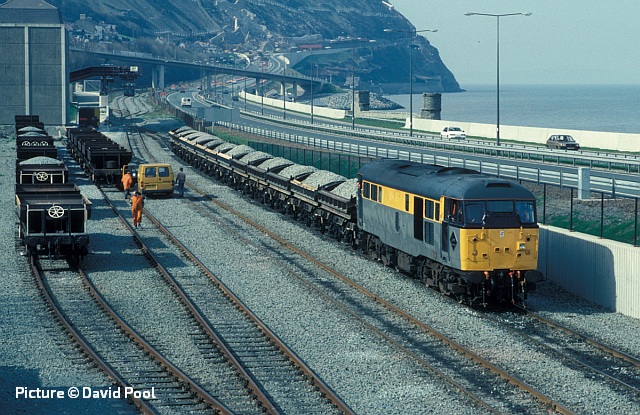
The sidings at Penmaenmawr were busy on 28 March 1991, where “Dutch” liveried 31 144 was preparing to leave with a train, probably for Crewe. On this occasion the stone was in “Mermaid” ballast wagons.
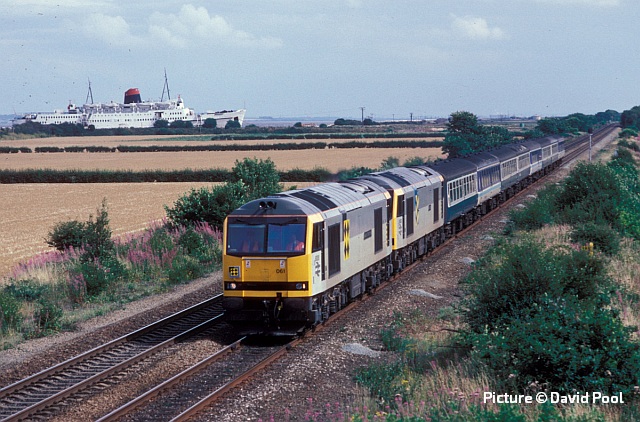
On 11 August 1991 Regional Railways and Trainload Coal sponsored a series of double-headed trains between Crewe and Llandudno in aid of a charity. Dave Sallery’s excellent website gives further details of the event. 60 061 (Trainload Coal) and 60 044 (Trainload Metals) are passing the beached “Duke of Lancaster” near Mostyn.
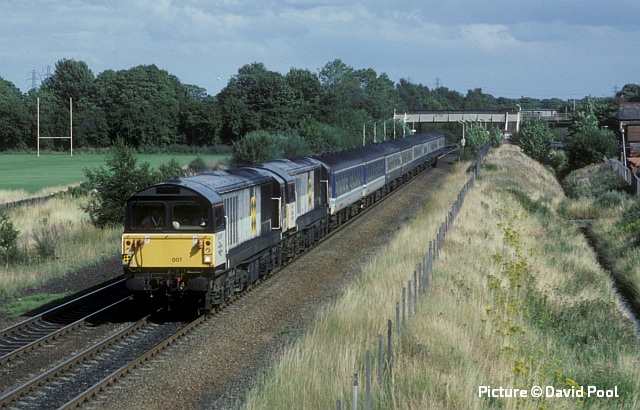
The appearance of two class 58s on the North Wales coast was highly unusual, and Trainload Coal 58 007 and 58 003 provided for me the highlight of the workings on 11 August 1991, here leaving Shotton Low Level station.
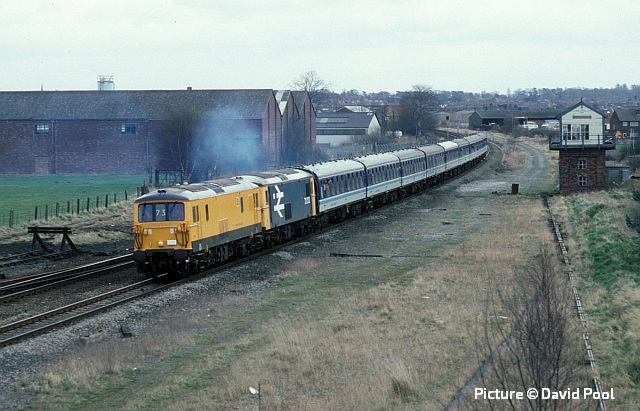
The use of the Merseyrail Electro-diesels in North Wales was another event not to be missed. On 12 March 1994 73 006 and 73 002 had the Chester to Llandudno Junction leg of the “Jolly JAs” Railtour. Passing Mold Junction signal box, they were working hard with a well loaded train.
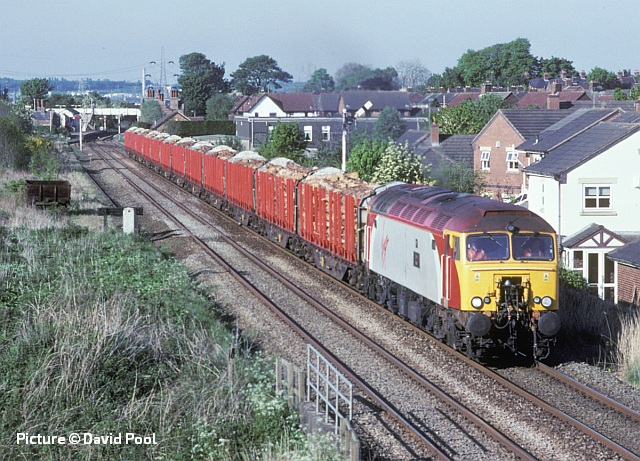
The Carlisle to Chirk log train has provided a remarkable variety of motive power over the years. On this occasion on 2 May 2007 Virgin “Thunderbird” 57 316 was being used on 6Z57 (13:29 Carlisle to Chirk) leaving Helsby. This vantage point from the bridge of the disused line to Mouldsworth is now closed off.
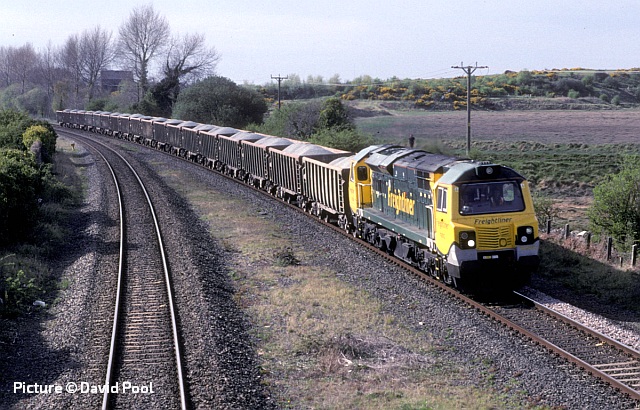
For a short time in 2010 a class 70 appeared on stone trains from Penmaenmawr. On 27 April 2010 70 002 was the locomotive for 6L56, 15:50 Penmaenmawr to Crewe, passing the site of Bagillt station. This was one of the last shots I took on Kodachrome film, before I changed to the Fuji Velvia I use today.
Parry's Railway Companion from Chester to Holyhead, Part 3
Transcribed by Geraint Rowlands.
[Edward Parry, a native of Chester, certainly did his best to drum up local trade whenever he could, as today's extract shows.]
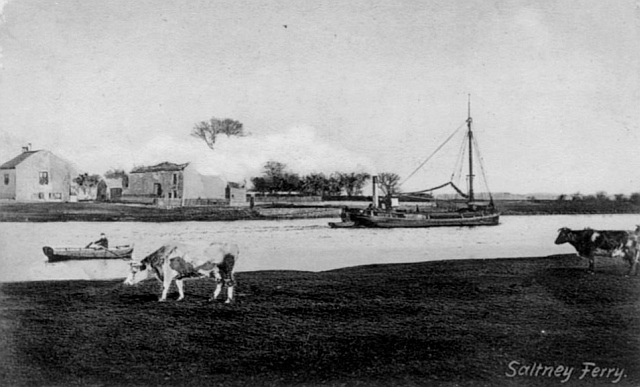
Immediately after passing over the Dee bridge, the carriages enter some deep cuttings through Brewer's Hall Hill, from which position the celebrated Oliver Cromwell with his cannon bombarded the city. About half a mile from hence will bring SALTNEY STATION, where the Wrexham, Ruabon, and Shrewsbury railway wheels off to the left; a branch of this line is connected with the quay on the right, where a vast quantity of Brombro, Ruabon, and other coals are shipped to various parts.
The tract of land we now enter upon is called Saltney, and was formerly granted by Robert the lord of Mold to the monks of Basingwerk for pasturage. In 1156, King Henry II. encamped on Saltney Marsh with a great army, which he had gathered from all parts of England for the purpose of subduing North Wales. Henry, too confident in the strength and discipline of his troops, ordered them to march forward, till at length his forces got entangled in some woods and other snares which were laid for them. The Welsh, under the command of Owen Gwynedd, sprang upon the enemy all of a sudden; and so fierce was the attack, that the cries of the English were horrible, and the slaughter equally dreadful.
The remaining part of the English were routed in all directions, and followed even to Henry's camp on Saltney Marsh. The line now runs parallel for several miles with the river Dee. The extensive tract of land on the right across the river is called SEALAND, Which has from time to time been enclosed from the sea, by the River Dee Company, constituted by Act of Parliament in 1732. This company was permitted to enclose the land on these terms:— "That they shall make and keep the new channel of the river Dee navigable from the sea to a certain point (close to the place where the railway passes over the river,) within the liberties of the city of Chester, in such manner that there shall be 16 feet of water (which was by a subsequent act reduced to 15 feet) in every part of the said river, at a moderate spring tide, for vessels to come and go to and from the city of Chester. It appears that the company have inclosed 4000 acres of land, from which they derive a very large income; but they have not fulfilled the other part of their contract, viz.— keeping the river navigable at 15 feet of water.
The situation of Chester is preeminently calculated to force an extensive trade, particularly now, being the terminus of no less five different railroads, which will bring it into immediate connection with all the manufacturing districts of Eng- land. There is no doubt that the port of Chester might be made a depot for a great portion of the agricultural produce of Ireland, which forms so considerable an item of the trade of Liverpool. The number of vessels employed in this trade in 1839 was 3395, carrying 517,807 tons, estimated at the value of £6,500,000! This amount since that time is no doubt much increased. We state these facts in the hope that they might be seen by some spirited parties who would be disposed to speculate and endeavour to procure a share of the traffic of Ireland to Chester, which offers great facilities by railway to all the manufacturing districts.
North Wales Coast home page | Archive | Previous Notice Board